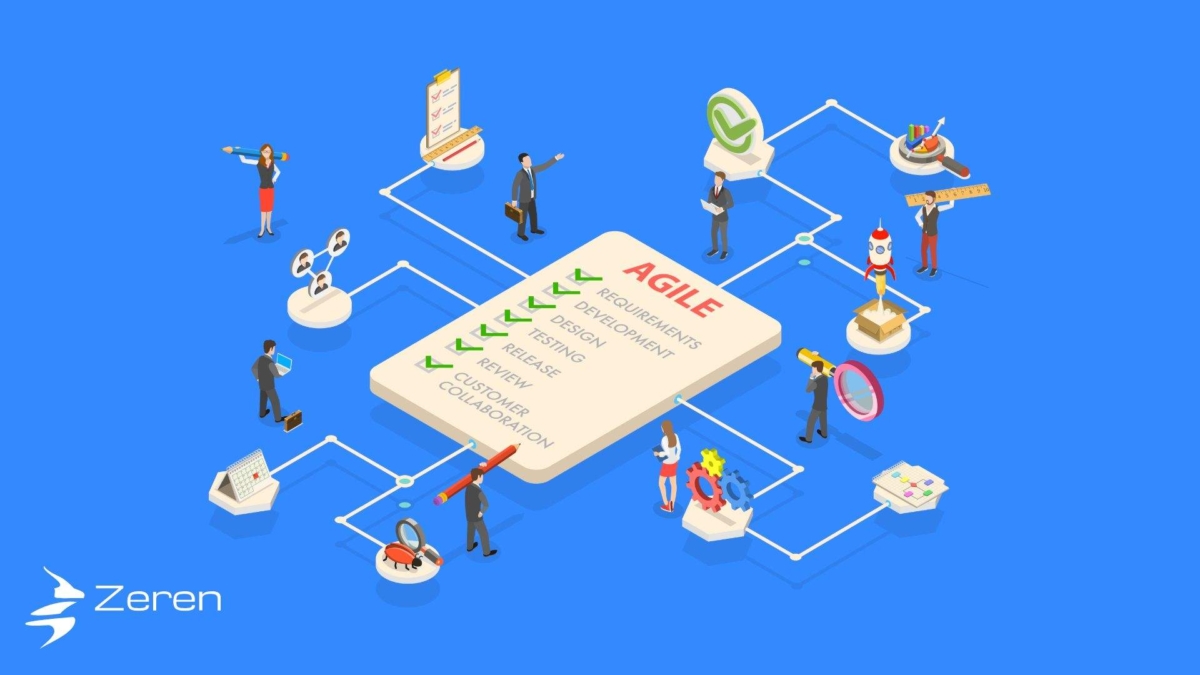Agile Development: Revolutionizing Software Production
Software development is a complex and dynamic process that requires constant adaptation and innovation. Traditional software development models, such as the waterfall model, often fail to deliver satisfactory results in today’s fast-paced and competitive market. They are rigid, linear, and sequential, making them prone to delays, errors, and inefficiencies.
That’s why more and more software developers are turning to agile development, a revolutionary approach that embraces flexibility, collaboration, and customer feedback. Agile development is a set of principles and practices that aim to deliver high-quality software solutions in a timely and cost-effective manner. Agile development is not a specific methodology, but rather a mindset that can be applied to various software development methods, such as Scrum, Kanban, XP, etc.
In this article, we will explore the principles of agile development, how it works in practice, and what benefits it offers to software developers and customers alike.
Principles of Agile Development
Agile development is based on four core values and twelve principles that guide the software development process.
The four core values are:
- Individuals and interactions over processes and tools: Agile development emphasizes the importance of human communication and collaboration over rigid procedures and standardized tools. Agile teams are self-organizing, cross-functional, and co-located, meaning that they have all the skills and resources they need to complete the project without relying on external dependencies or intermediaries.
- Working software over comprehensive documentation: Agile development focuses on delivering functional and valuable software products over producing extensive and detailed documentation. Agile teams prioritize customer satisfaction over contract negotiation, meaning that they are flexible and responsive to changing requirements and feedback. Agile teams produce minimal but sufficient documentation that supports the software development process, such as user stories, acceptance criteria, test cases, etc.
- Customer collaboration over contract negotiation: Agile development involves close and frequent interaction with the customer throughout the software development process. Agile teams seek to understand the customer’s needs and expectations, deliver working software incrementally and iteratively, and incorporate customer feedback into each iteration. Agile teams aim to build trust and partnership with the customer, rather than following a fixed and rigid contract.
- Responding to change over following a plan: Agile development embraces change as an opportunity for improvement and innovation. Agile teams are adaptive and resilient to changing market conditions, customer demands, and technological advancements. Agile teams plan their work in short cycles or iterations, allowing them to inspect and adapt their product and process regularly. Agile teams welcome changing requirements, even late in development, as they can deliver a better product that meets the customer’s needs.
The twelve principles of agile development are:
- Our highest priority is to satisfy the customer through early and continuous delivery of valuable software.
- Welcome changing requirements, even late in development. Agile processes harness change for the customer’s competitive advantage.
- Deliver working software frequently, from a couple of weeks to a couple of months, with a preference to the shorter timescale.
- Business people and developers must work together daily throughout the project.
- Build projects around motivated individuals. Give them the environment and support they need, and trust them to get the job done.
- The most efficient and effective method of conveying information to and within a development team is face-to-face conversation.
- Working software is the primary measure of progress.
- Agile processes promote sustainable development. The sponsors, developers, and users should be able to maintain a constant pace indefinitely.
- Continuous attention to technical excellence and good design enhances agility.
- Simplicity–the art of maximizing the amount of work not done–is essential.
- The best architectures, designs, and requirements emerge from self-organizing teams.
- At regular intervals, the team reflects on how to become more effective, then tunes and adjusts its behavior accordingly.
Agile Development in Practice
Agile development can be implemented using various methods or frameworks that follow the agile principles and values. Some of the most popular agile methodologies are:
- Scrum: Scrum is an iterative and incremental framework that divides the software development process into fixed-length cycles called sprints. Each sprint lasts from one to four weeks and consists of four main events: sprint planning, daily scrum, sprint review, and sprint retrospective. During sprint planning, the team selects a subset of user stories (features or requirements) from the product backlog (a prioritized list of user stories) that they can complete within the sprint. During daily scrum, the team meets for 15 minutes to synchronize their work and plan for the day. During sprint review, the team presents the working software they have produced during the sprint to the customer or stakeholders for feedback. During sprint retrospective, the team reflects on their performance during the sprint and identifies areas for improvement. The team also has three main roles: product owner (the person who represents the customer’s interests), scrum master (the person who facilitates the scrum process), and development team (the people who design, build, and test the software).
- Kanban: Kanban is a flow-based framework that visualizes the software development process as a series of stages or columns on a board. Each stage represents a different phase or activity in the process, such as backlog, analysis, development, testing, deployment, etc. Each user story or task is represented by a card that moves from one stage to another as it progresses through the process. The main principles of Kanban are: visualize the workflow, limit the work in progress (WIP), manage the flow, make policies explicit, implement feedback loops, and improve collaboratively. Kanban helps to optimize the flow of work and reduce waste and bottlenecks.
- XP (Extreme Programming): XP is an agile methodology that emphasizes technical excellence and customer satisfaction. XP practices include: user stories (short descriptions of features or requirements written from the user’s perspective), test-driven development (writing automated tests before writing code), pair programming (two developers working together on the same code), continuous integration (merging code changes frequently and running tests automatically), refactoring (improving the code quality without changing its functionality), collective code ownership (any developer can modify any part of the code), simple design (choosing the simplest solution that works), coding standards (following consistent and agreed-upon rules for writing code), and on-site customer (having a representative of the customer available to provide feedback and guidance).
Benefits of Agile Development
Agile development offers many benefits to software developers and customers alike. Some of the main benefits are:
- Faster delivery: Agile development enables software developers to deliver working software faster and more frequently, reducing the time to market and increasing customer satisfaction.
- Higher quality: Agile development ensures software quality by incorporating testing, feedback, and improvement into every iteration, reducing defects and errors.
- Lower cost: Agile development reduces software development cost by eliminating waste, rework, and overhead, optimizing the use of resources and maximizing the value delivered.
- Greater flexibility: Agile development allows software developers to adapt to changing requirements, feedback, and market conditions, delivering a product that meets the customer’s needs and expectations.
- Better collaboration: Agile development fosters collaboration and communication among software developers, customers, and stakeholders, creating a shared vision and understanding of the product and the process.
Conclusion
Agile development is a revolutionary approach that has transformed the way software is produced and delivered. By following the agile principles and values, software developers can create custom software solutions that are flexible, iterative, and customer-centric. Agile development also offers many benefits, such as faster delivery, higher quality, lower cost, greater flexibility, and better collaboration.
If you are looking for a reliable and experienced partner to help you with your agile software development project, look no further than Zeren Software. We are a leading provider of agile development solutions for businesses of all sizes and industries. We have a team of skilled and certified developers who can help you design, develop, and deploy your custom software solution using agile methodologies. Whether you need a web application, a mobile app, a desktop software, or a cloud-based solution, we can help you create it with rapid iteration and flexible development.
We look forward to hearing from you and helping you with your agile software development project. We hope you found it useful and informative.








